Whether you are stripping paint from a small section of your classic car or removing paint from the whole car all at once, below is the complete guide to the most popular automotive paint stripping methods out there so you can choose what’s best for your car.
Some methods are low budget DIY and some are expensive. For example, drop-your-car-off-and-have-it-done-for-you solutions or dipping solutions, ha ha. Seriously, you can dip your car too.
Best Chemical Paint Stripper
Automotive paint strippers aren’t as good as they once were due to EPA and safety regulations. One key ingredient, Methylene Chloride, has been banned for use in paint strippers.
I found that these products still work, but they take much longer to eat into the paint. Here’s the industrial one that I prefer:
Plan on using one or more gallons of the paint stripper above to strip an entire car.
Before the product above, I used aircraft stripper from Klean-Strip. Their new formulation is not impressive in my opinion, but if you want to try I suggest you buy a quart or pint size first.
Also check with your local or online automotive paint supplier for full strength paint stripper with MEK. Apparently some states still offer stronger solutions, but you won’t find them in retail big-box stores.
Chemical Paint Strip Procedure
- Best to scratch paint surface with 80 Grit Sandpaper
- Cover seams or gaps with masking tape
- Pour chemical paint stripper onto horizontal surfaces and cover with plastic
- Brush chemical paint stripper onto vertical surfaces.
- Brush on heavy and in one direction only.
- Wait 20 or more minutes after bubbling appears to stop.
- Scrape paint off with metal or plastic scraper tool
- Re-apply to attack multiple layers of paint
- Neutralize with denatured alcohol or soap and water
- Epoxy prime same day (follow primer directions, but most need 80 Grit DA sand).
Do NOT use the method above for fiberglass or plastic parts. The stripper can damage the gel coat and the epoxy resin that creates the fiberglass structure. If you are working with fiberglass or plastic, skip to the mechanical or blasting methods below.
It’s important not to mess with the chemical once it’s applied to the surface. I find that the chemical works best in areas that I poured the chemical.
You want the chemical gel thickness to be about 1/8″ which is kind of hard to do on vertical surfaces. If you plan on removing the doors anyway, it may make sense to remove them first so the stripper can work horizontally covered with a plastic sheet.
I will typically pour enough chemical in rows about 8-10″ apart and then gently pull the chemical with a brush for even coverage. Remember not to over brush it!
Often, the paint will soften but not scrape off easily. This is where I like to combine the chemical strip method with mechanical methods, such as a surface conditioning tool or a strip-it disc. See Mechanical Methods below.
You will see in the pictures above that the hood to fender seams were taped up. This step is critical for the perfect paint job. You do not want the chemical to hide in any seams and then leak out in a few years to destroy your new paint. Do not use paint stripper on hemmed door skins or anything that may trap acids!
Chemical PROS
- Inexpensive
- Minimal dust
- EASY for horizontal surfaces
- Gentle to steel
- NO warping
Chemical CONS
- MUST be neutralized
- BAD for seams
- Slow with today’s product
- BAD for plastic
- BAD for fiberglass
Mechanical Paint Strip Method
Sometimes a little “elbow grease” is need to get the job done safely. Since automotive paint strippers are not as good as they used to be, a good DIY alternative is mechanical paint removal.
Luckily there have been some improvements in this area lately. Two great products now replace the heavy sandpaper option.
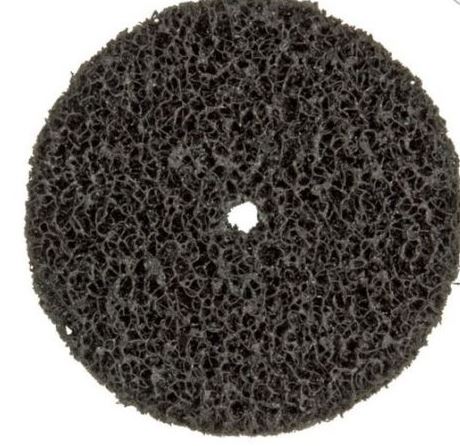
7″ Strip-It Disc
Works great on low speed sander such as the Makita with a plastic backing pad.

Surface Conditioning Tool
Designed for automotive paint removal
Both the strip-it disc and surface conditioning tools utilize a woven abrasive medium that will not clog up like sandpaper. Both will mow through Bondo, paint, and even light surface rust. You will be left with a clean shiny surface that is ready for epoxy primer. Most primer manufactures suggest an 80 grit abraded surface and these both get close enough to that.

The price and availability of this woven material has come down substantially in recent years. The large 7-8″ discs can be hard to find, but they are out there. Click here to buy.
I believe that the typical 4.5″ angle grinder is a bit too fast and it will wear the woven discs out quickly. That is why I prefer the Makita sander at about 3000 RPM. One 7″ disc will strip an entire car if you don’t push to hard and let the tool do the work.

I believe that the typical 4.5″ angle grinder is a bit too fast and it will wear the woven discs out quickly. That is why I prefer the Makita sander at about 3000 RPM. One 7″ disc will strip an entire car if you don’t push too hard.
As mentioned above in the chemical stripping section, I like to combine both methods. Soften the paint with paint stripper, scrape off the easy stuff and then use the mechanical method. If the paint doesn’t come off in large balls, then it may be time to add more stripper. Softened paint usually doesn’t create too much dust if done correctly. If you want to see this method in action , please click the video at the bottom of this article. This video shows me stripping my Porsche 911 in only one day.
The one limitation I have found with woven material tools, is that they don’t work very well on undercoating. They can clog and bog down.
Undercoating Is Tough To Remove, Try This
- Wire wheel on drill or 4.5″ angle grinder
- Propane torch and metal scraper
- Oscillating slicer tool
Click to here to read my undercoating removal article
Mechanical PROS
- Inexpensive
- Gentle to metal
- Do at home (hire a laborer)
- Safe for seams
- Ready to epoxy prime
- Can do one panel at a time
Mechanical Cons
- Dusty
- Labor Intense
Media-Blasting Car Paint Removal
A lot of car enthusiasts prefer to tow their project car to a professional sandblaster. Professional blasters use very high volume airflow that is difficult to achieve at home. If you want your whole car stripped with this method, a professional outfit with quality equipment is the only way to go. Some blast businesses will come to you with a mobile blast rig.
CAUTION: The high pressure abrasive media can warp large panels like hoods or doors if not operated by a skilled blaster.
If you are concerned about warping large panels, then use either chemical or mechanical methods first for those large, easy to reach areas.
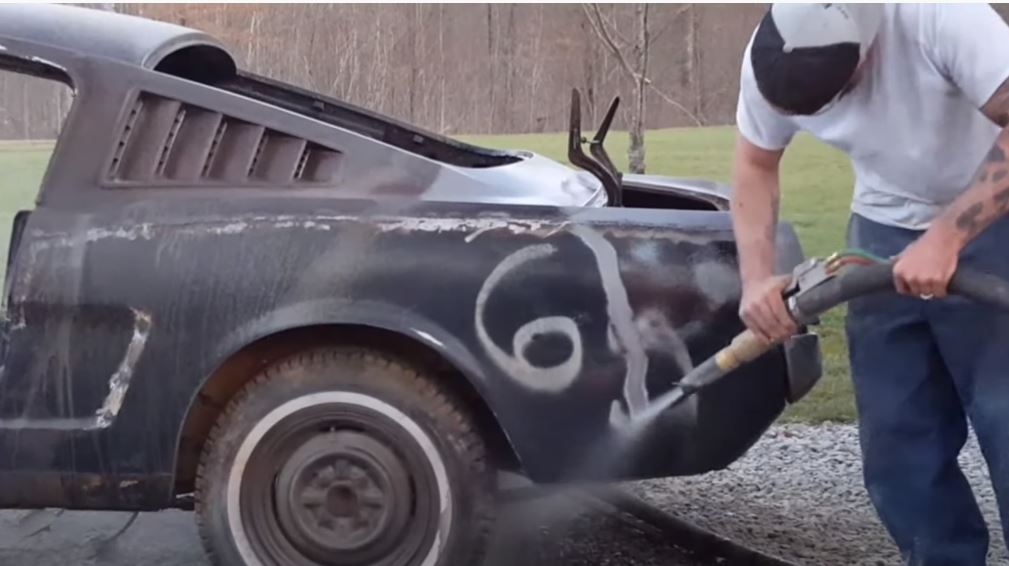
Large Blaster 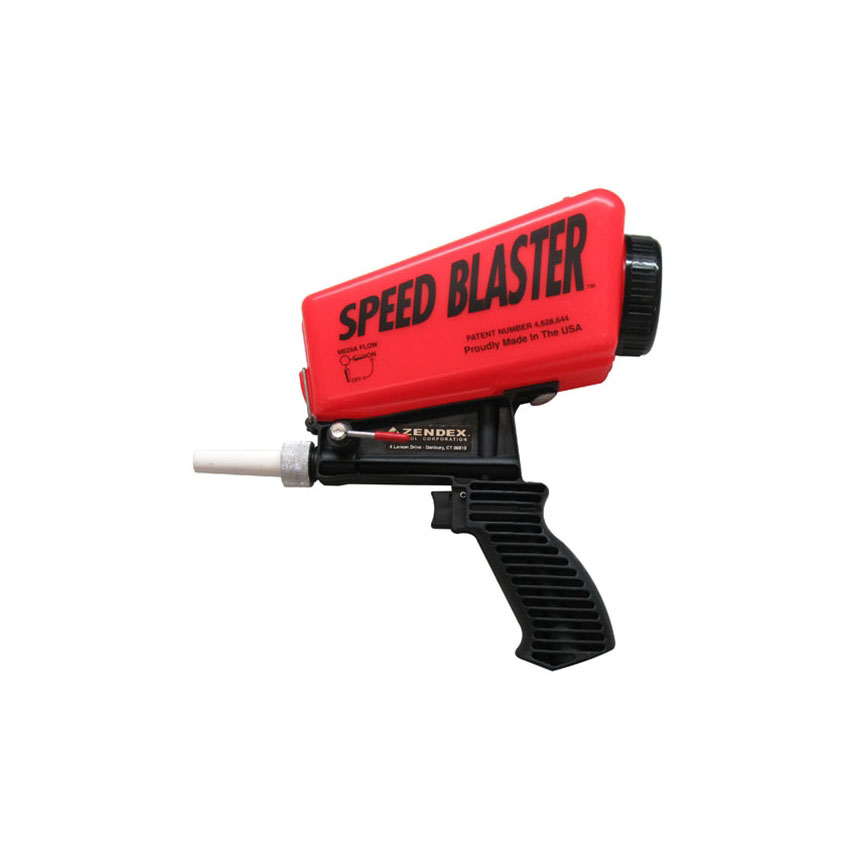
Spot Blaster for Small Areas
Common blast materials for paint removal
- Walnut shells
- Glass beads (rust removal)
- Soda (Sodium Bicarbonate)
- Sand, various grits
- Vapor (mixture of water and above media)
- Dry Ice
Depending on the paint thickness and shape of the panel several different media may be needed.
The major advantage of sandblasting is that it is great at removing rust, especially on hard to reach surfaces. If you are restoring a very rusty car it’s common to cut out the bad metal to expose inner cavities for the most thorough job. Often times this is for a full rotisserie restoration when the doors, hood, etc are removed for a full restoration.
If you do cut out known bad metal, then some bracing may be required so the chassis doesn’t flex too much and permanently distort.
Blasting PROS
- Done for you
- Great for rusty areas
- Quick
- Dry Ice (least obtrusive)
Blasting CONS
- Expensive ($2-3k for professional job)
- May warp if not careful
- Glass/Shells/Sand gets everywhere
- Must tow car to shop or have large outdoor space at home
- Must Neutralize Soda if used
Acid Dipping Paint Removal
Automotive paint stripping can be extreme! You can dip your entire car in an acid sequence too to remove paint.
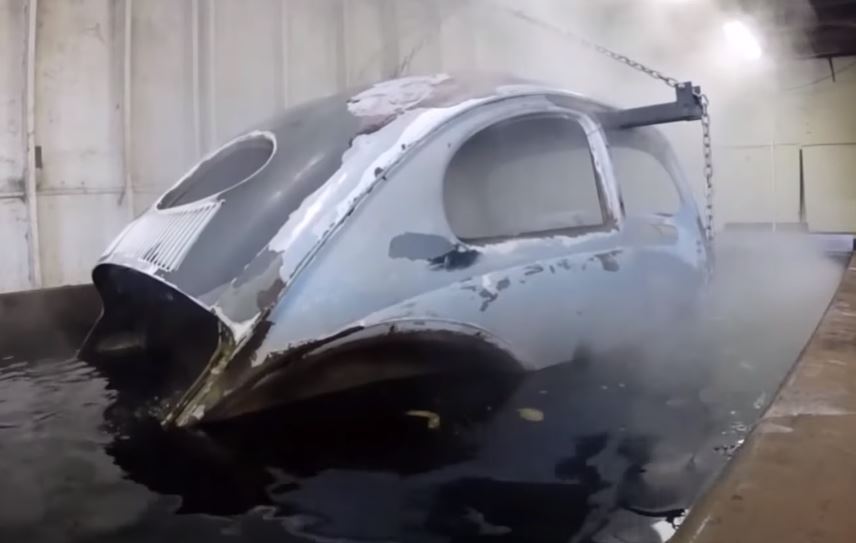
Clearly this method requires that everything must be removed from your car prior to dipping. It’s also best to remove any plugs that may prevent the acid solution from entering hidden cavities and channels. Trapped air is one short coming of this method, so plan ahead.
Acid dipping a whole car is certainly a professional endeavor so make sure you ask lots of questions to whomever has the equipment to do the job right.
I like this methods for really rusty or thin metal cars such as the VW Beetle pictured above. The acid can remove rust too, so if you have a lot of pitted metal dipping can clean it.
You do need to ensure that the acids are neutralized properly before new paint is applied. Often this is done with high pressure water to flush away the residue and debri left behind.
I recommend heating the seams to boil any left over stuff in the spot welded seams as chemicals tend to leech out and ruin your pretty paint job. This may not happen for several years, so keep your fingers crossed.
Most dipping outfits will coat the car in a phosphate solution to prevent flash rust. Make sure that your primer manufacture says their product can be applied over a phosphated surface. Very important!
Electrolysis For Rust Removal
Another dipping method that I like is electrolysis. While it’s not an acid, it does involve an electrolyte solution and electricity. This method is great for small parts and the process is self limiting, meaning that once the rust if gone the process stops. Electrolysis is great for small delicate parts that you don’t want to abrade or texture with mechanical or blasting methods.
Dipping PROS
- Thorough Rust Removal
- Quick once car is prepped
- No Warping
Dipping CONS
- Acids can leech through future paint
- Everything must be removed
Watch this video which summarizes and highlights each of the above methods. Sometimes watching someone else work on their project can inspire you to give it a try.
Car Paint Stripping Summary
Automotive paint stripping really comes down to cost, versus, time, versus quality. What do most of the high end restoration shops use on very valuable cars?
They use either dry ice blasting and/or mechanical methods. Mechanical methods ensures great paint adhesion so if quality and reputation is important to your business or project, then you must spend the time and money to do it right.
If you are tired of working on a rusty car and you feel like there is no end in sight, then send it to a media blaster. Many guys find that outsourcing the rust removal is a major win because they feel the car is fresh and ready to build!
If you have any questions in particular please leave a comment below and I’ll do my best to get back to you.

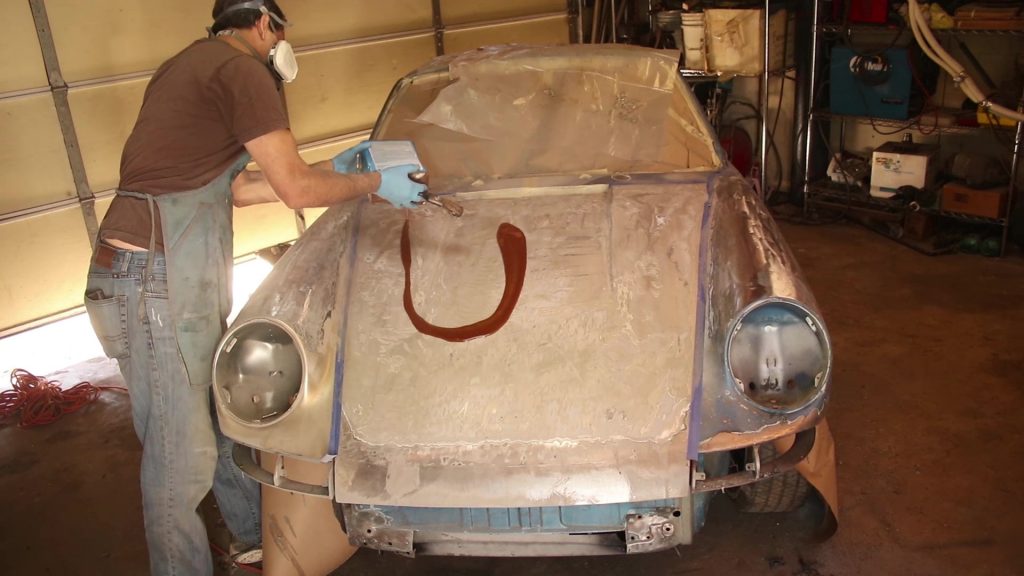
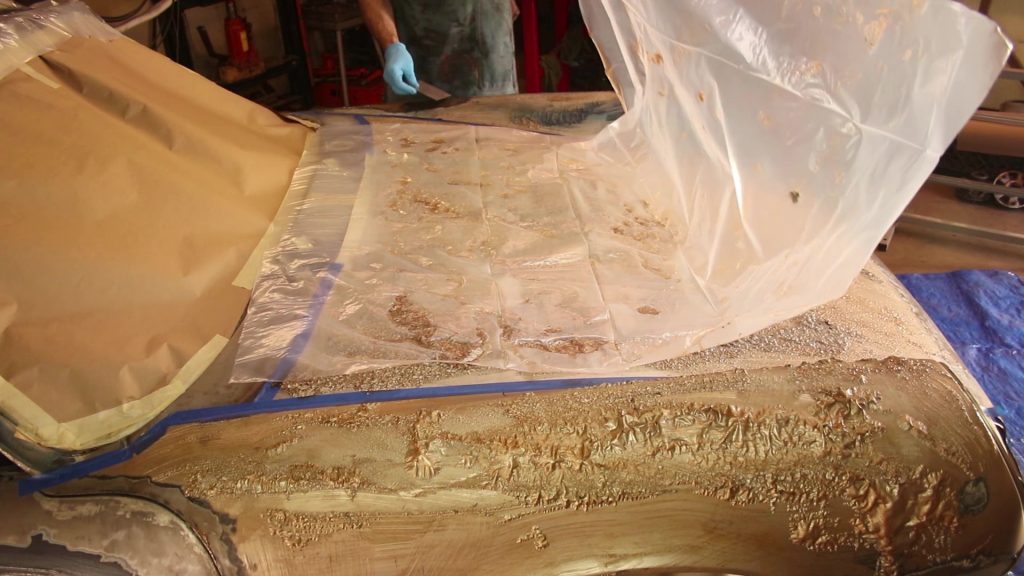

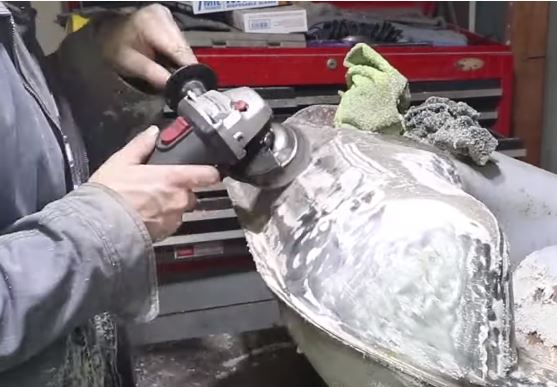




Hi,
Actually my budget is very limited,
So can you say any heat gun to remove the paint would be good for me?
With which I can remove paint on metal, wood, walls and more? And how long will it last?
I don’t think a heat gun will do much for automotive paint. If you are on a budget, then I recommend the 7″ strip it disc on a drill.
That’s $20 and faster than a heat gun!
I have been following posts. I perpetually find you articles enlightening.
Hi, I just ran across your blog via Bing. Your article is truly pertinent to my life at this moment, and I’m really happy I discovered your website.
Wow, this was very interesting to read. Have you ever considered submitting articles to magazines?
Thanks! If any automotive magazine would have me! I’m currently doing most of my work in video format on YouTube. Same name ahh garage time
I discovered your site on bing and read a few of your early posts. I hope you will continue the very good work. I just added your RSS feed to my MSN News Reader. Im seeing forward to reading more from you later on!
Thanks! I hope to write hear more, but I’m currently doing more in video format on YouTube.
Same name, ahh garage time